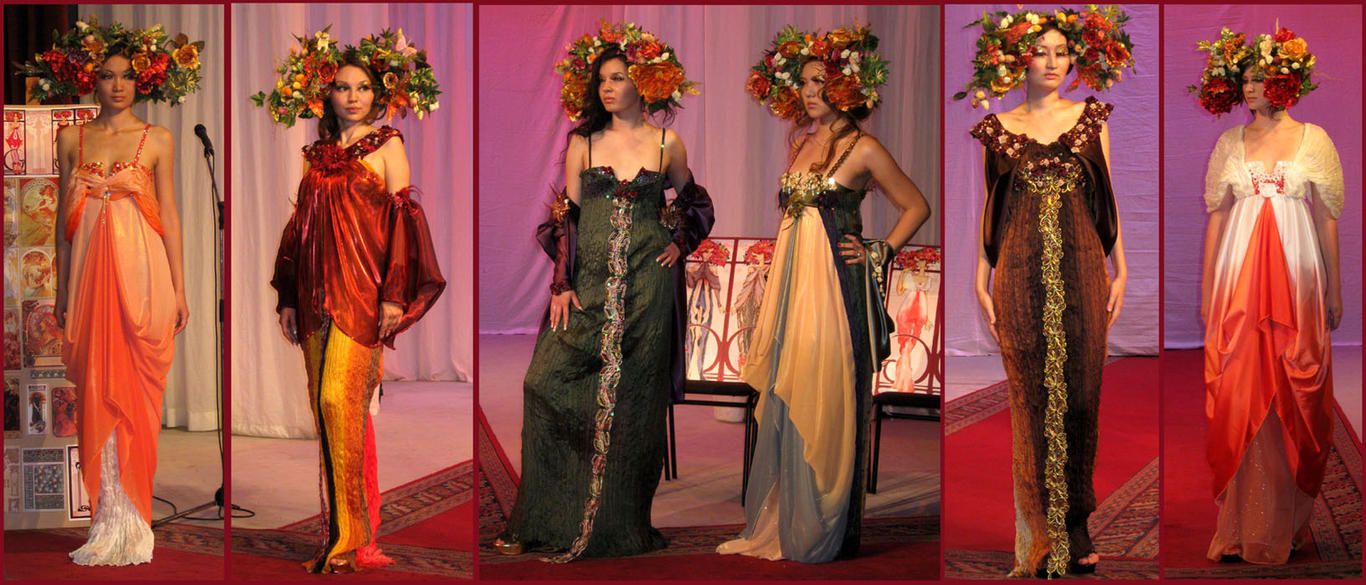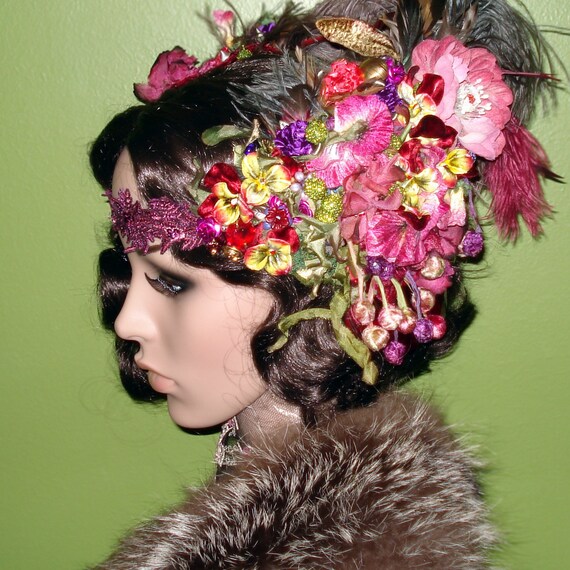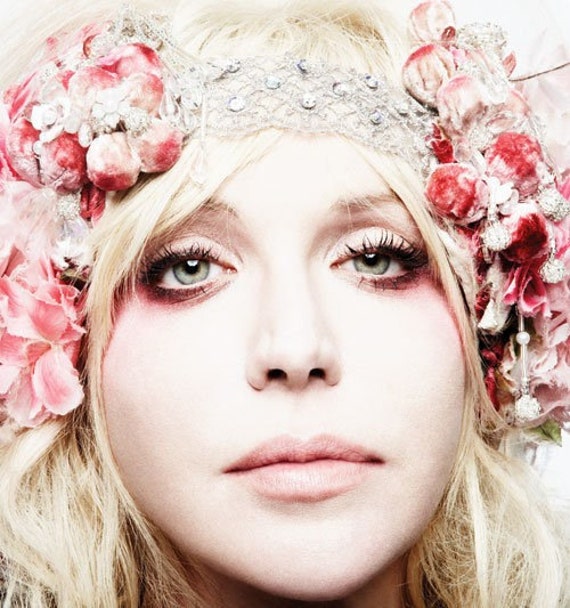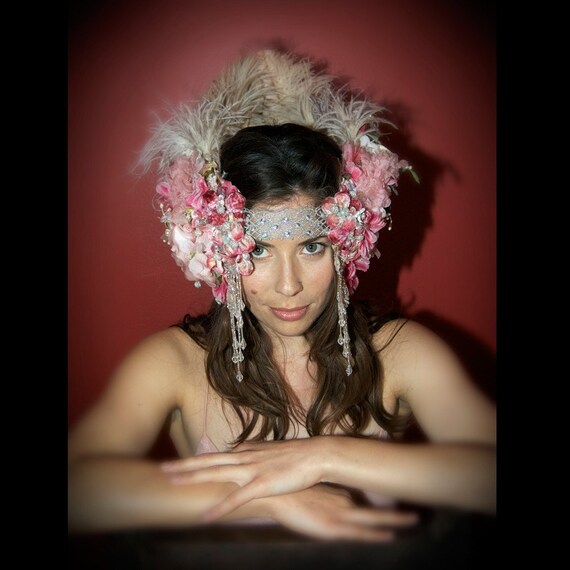 |
| Chanel Haute Couture SS09 |
These Origami style headdresses are so intricate and gorgeous
 |
| "The Brunnette" by Alphonse Mucha |
 |
| Diane von Furstenburg A/W '09 |
 | ||
| From article on http://www.whowhatwear.com/ After doing some market research I was very excited to see that bib necklaces are going to be a popular trend throughout 2011. They can be anything from big chunky plastic shapes to soft fabric ones, but they all have one thing in common- the ability to bring more colour and texture to any textile piece, often seamlessly disguising themselves as part of the garment beneath them. Many, many designers have featured bib necklaces in their 2010-2011 collections, including Vera Wang, whose 2010 Spring RTW collection was decorated with an abundance of bib necklaces:
The best thing about them is their striking resemblance to Alphonse Mucha's artwork. I think a bib necklace could be a very effective, creative and modern way of incorporating his Art Nouveau influence into a textiles piece. Below I have posted some possible bib necklace inspiration from the Art Nouveau works of Mucha. |

 |
| By Fashion-KazNAI |
 |
| From the 'Liason' collection by Kat Swank |
 |
| From the 'Liason' collection by Kat Swank |
 |
| From the 'Liason' collection by Kat Swank |
 |
| From the 'Liason' collection by Kat Swank |
 |
| From the 'Liason' collection by Kat Swank |
"At the time of his death, Mucha's style was considered outdated. His son, author Jiří Mucha, devoted much of his life to writing about him and bringing attention to his art. In his own country, the new authorities were not interested in Mucha. His Slav Epic was rolled and stored for twenty-five years before being shown in Moravsky Krumlov and only recently has a Mucha museum appeared in Prague, run by his grandson, John Mucha.[4]Mucha's work has continued to experience periodic revivals of interest for illustrators and artists. Interest in Mucha's distinctive style experienced a strong revival in the 1960s (with a general interest in Art Nouveau)[7] and is particularly evident in the psychedelic posters of Hapshash and the Coloured Coat, the collective name for two British artists, Michael English and Nigel Waymouth, who designed posters for groups such as Pink Floyd and The Incredible String Band.It is a strongly acknowledged influence for Stuckist painter Paul Harvey whose subjects have included Madonna and whose work was used to promote The Stuckists Punk Victorian show at the Walker Art Gallery during the 2004 Liverpool Biennial.[8]The Japanese manga artist Naoko Takeuchi released a series of official posters depicting five of the main characters from her manga series Sailor Moon mimicking Mucha's style. Another manga artist, the 1962 born Masakazu Katsura has also mimicked Mucha's style several times. Comic book artist and current Marvel Comics Editor in Chief Joe Quesada also borrowed heavily from Mucha's techniques for a series of covers, posters, and prints.Among his many other accomplishments, Mucha was also the restorer of Czech Freemasonry.[11]On 1 January 2010, his published works went out of copyright and entered the public domain."
Extract from Lines and Colors:
"Alfons Mucha, whose name is usually Anglicised as Alphonse Mucha, was a Czech painter and graphic artist. While living in Paris in he late 1800′s he adopted a style that was to to become what most of us think of as Art Nouveau (orginally referred to as “Le style Mucha”). Mucha disliked the term “Art Nouveau”, saying that art was eternal and never just “nouveau”, and tried unsuccessfully to distance himself from the label for the rest of his career.
After years of difficulty living as a proverbial “starving artist”, Mucha achieved acceptance and fame as the result of his posters for Sarah Bernhardt and other theatrical figures of the day.
His work has been very influential on other artists. When illustrators or comic book artists today do their version of “Art Nouveau”, they’re basically doing their take on Mucha. Illustrators notwithstanding, I think his influence on the course of art, design and our culture in general is dramatically misunderstood and undervalued.
In an age when the industrial revolution was making mass-produced goods available, it also seemed to be increasingly making them ugly and diminishing the role of the artist/craftsman in society. Art Nouveau was a revolt against this uglyness and there is a strong social component to the work that we no longer see.
Printing technology had just changed and the artists associated with the Art Nouveau style believed in bringing art to every aspect of life, removing the dividing line between art and commerce, between beauty and utility, between “high art” and “low art”, and most importantly, between the elite and the public, making art available to everyone, not just the rich.
Mucha designed labels for champagne, liquors, biscuits, perfume, even cigarette paper (much to the delight of counterculture types in the 1960′s, when Mucha’s work experienced a revival).
Mucha was a brilliant designer as well as an artist and his style also broke down the barrier between art and design. His drawings blended inextricably with the design elements of the work. His elegant curveuliear forms and Byzantine surface decoration extended into, and became part of the drawing.
Most of us have grown up taking Art Nouveau for granted as “pretty” or “decorative”. It’s difficult for us to realize what a revolution in design Mucha’s style was at the time. It’s also difficult to get a feeling for the turnabout in the place of art in society that Art Nouveau represented.
The art Nouveau artists were contemporary with the Impressionists. (Surprised? I was.) Mucha shared a studio with Gauguin for a while. Our fascination with Impressionism, combined with our modernist-induced snobbery and “Art for Art’s sake” elitism, prevent us from seeing the contribution of Mucha and the Art Nouveau movement to our culture.
Mucha spent the last years of his life creating the twenty monumental canvases of the Slav Epic, a history of the Slavs that he considered his masterpiece. If you think you know Mucha from his posters and labels, but haven’t seen his painting and drawings, you’re missing out.
The official Mucha website is maintained by the Mucha Foundation and has a good sampling of his work. The Art Renewal Center has excellent reproductions of Mucha drawings and paintings as well as posters and labels. There are also good images in the imageNETion gallery, and a good biography of Mucha here.
Mucha published two books to make his style more available to graphic artists and others, Documents Decoratifs and Figures Decoratifs (Amazon links to Dover editions), the latter is full of drawings of figures and draperies in pencil, pen, charcoal and chalk. Dover also publishes inexpensive editions of other Mucha drawings as well as a nice Mucha Postcard book. For better editions, though, look for “Alphonse Mucha” by Sarah Mucha, or (even better but more expensive), “Alphonse Mucha : The Spirit of Art Nouveau” (Victor Arwas, Jana Brabcova-Orlikova, Anna Dvorak)."
'[Art Nouveau is] a French school of art and architecture popular in the 1890s; characterized by stylized natural forms and sinuous outlines of such objects as leaves and vines and flowers.'